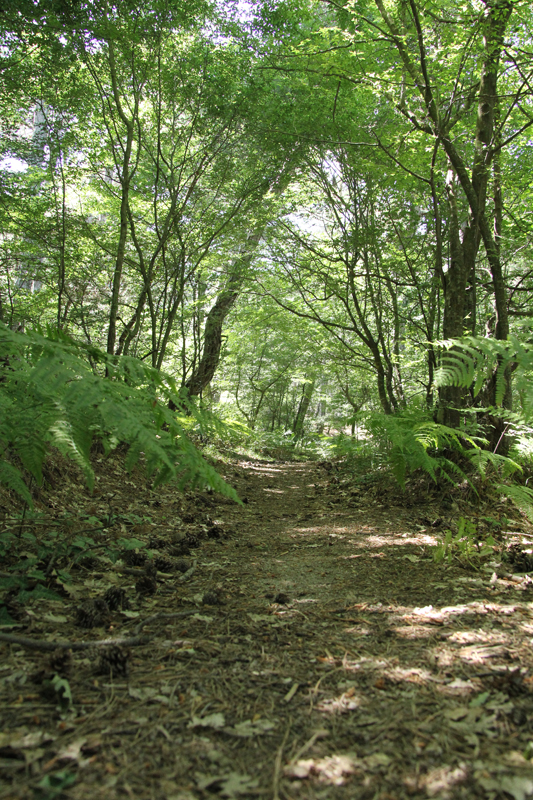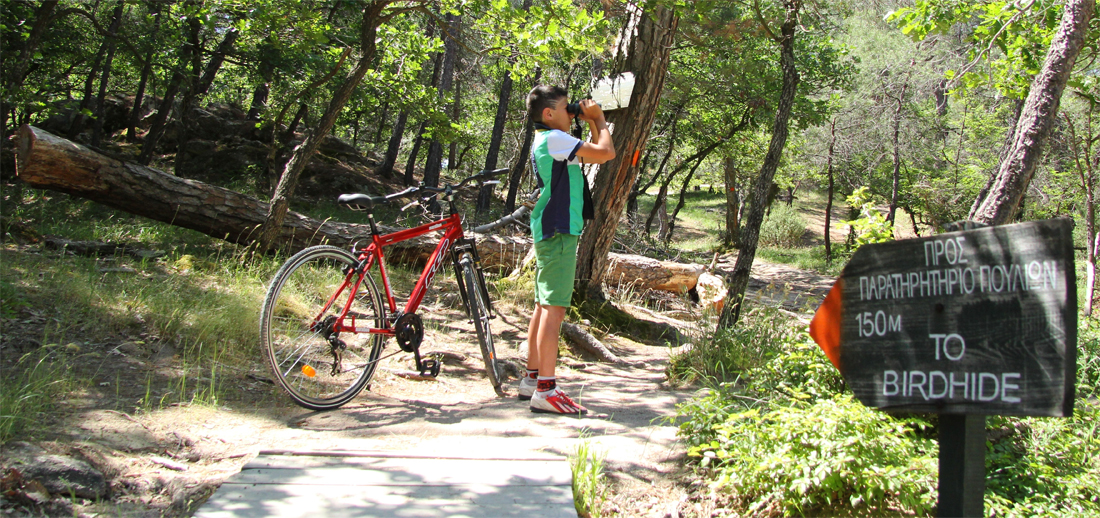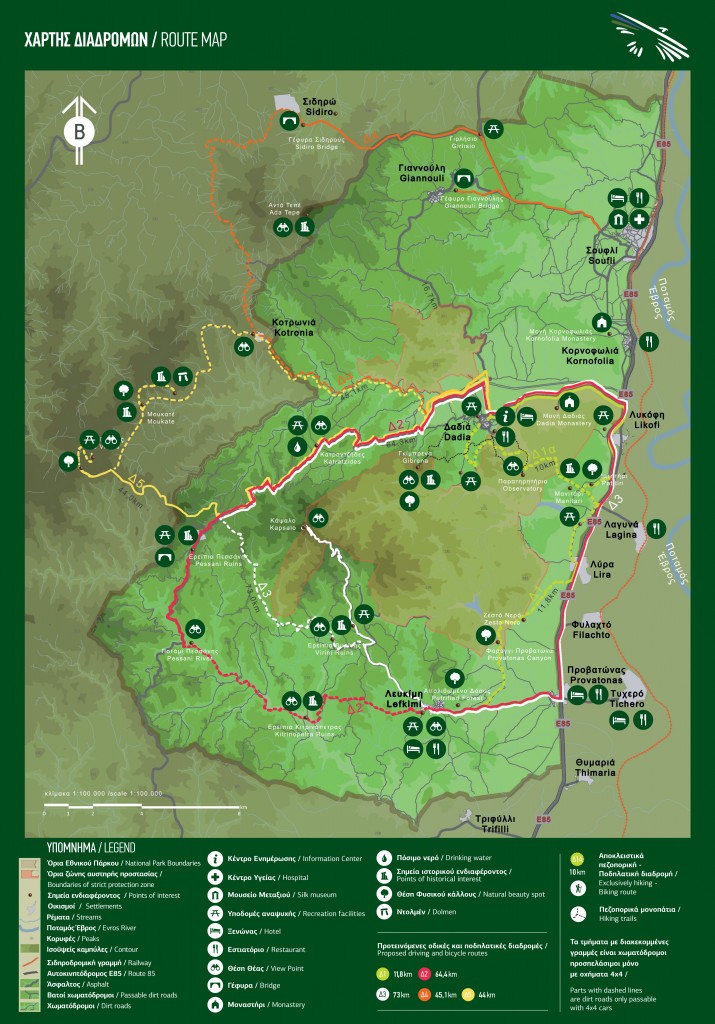Road trips
Parts of the following routes comprise of dirt roads accessible only by 4×4 car or bicycle. If you own a conventional car and you wish to tour around the National Park, you should first contact the Information Center to be informed about the road conditions.
Route 1: Dadia-Birds of Prey Observatory -Lyra-Lefkimi

Route 2: Dadia-Fossilized forest of Lefkimi-Kitrinopetra-Dadia
If you take the main road that leads from Dadia to Alexandroupolis and turn right at the traffic lights of Provatonas, you will reach the village of Lefkimi. There you may visit the oldest fossilized forest of Greece with the very well preserved rare plant fossils, that date back to about 30.000.000-40.000.000 before present. Heading southwest, you will reach the abandoned settlement of Kitrinopetra, where the open landscape is dominated by hedgerows across the fields, that constitute a source of food and shelter for dozens of small birds, among which are the Masked Shrike and the Isabelline Wheatear. Then the road descends and meets the pompously named creek “Mega Rema”, where you will have the opportunity to watch a very large number of birds, like Lesser Spotted Eagles, Short-toed Eagles, the Booted Eagles, Shrikes, Bee-eaters at many other. The road follows the river and along the way you are very likely to hear or see Levant sparrowhawks landing into the splinters where they usually nest.
The dirt road ends at the bridge of Pessani, meeting the paved road that connects Dadia to Alexandroupolis. This crossroads is the ideal site for watching birds such as the Middle Spotted Woodpecker and the Orphean Warbler. After a short stop to enjoy the view to the of Pessani river you will find among the ruins of the old settlement the belfry, a well preserved old stone bridge and some water fountains that are distinguished for their unique style. Besides the fruit trees that dominate the site, garland thorns and cloudberries are currently abundant, hosting the rare Olive-tree Warbler, Sylvia Warblers and other birds. Finally, taking the paved road, with the Kapsalo peak rising on your right, you will reach the recreation area of Katratzides, where you may have a rest.
Route 3: Dadia-Lefkimi-Kapsalo-Vyrini-Dadia

Heading south from Dadia, following the main road to Alexandroupolis, you turn right at the Provatonas traffic lights and you reach Lefkimi, with the rocky landscape. There you may visit the Church of Virgin Mary’s Assumption, one of the oldest churches in the area with the wooden temple dating back to the 17th century and the Church of Virgin Mary’s Birth, one of the most beautiful churches of the region with many icons made by painters from Edirne, dating to the beginning of the 20th century. Before reaching Lefkimi you will find the fossilised forest with the rare plant fossils. If you follow the paved road North-West from the village you will get to Kapsalo peak (580 m), the highest peak within the boundaries of the National Park, where you will enjoy the stunning panoramic view, while with some patience you will have the chance to watch vultures and other birds of prey flying close to you. On the way back you will cross the ruins of Vyrini where you may watch many small birds flying around , as well as the recreation area of Katratzides, where you may have a rest before getting back to Dadia.
Route 4: Dadia-Kotronia-Sidiro-Giannouli-Soufli-Kornofilia-Monastery of Dadia
Starting from Dadia and heading towards the west, along the boundaries of the strictly protected zone, following the river and crossing the ravine with its imposing and beautiful landscape you will be driven to a valley at the confluence of a tributary, where with some luck, you may see plenty birds of prey and small birds. After five kilometers, the road leads to the small village of Kotronia, where few families still reside. The view from this spot is stunning, as you can see the closest hills of the Rhodope Mountains, as well as the valley of Evros River and the Hellenic-Turkish borders. The landscape in Kotronia is open, thus suitable for bird watching. After a short stop to enjoy the view, you will head to the settlement of Sidiro with the reconstructed stone bridge and the AdaTepe peak rising on your right, through an enchanting route in the forest that will reward those who decide to visit the boundaries of the National Park. Then you will meet the recreation area of Girlisio and the settlement of Giannouli where you may stop to have a rest and walk on the beautiful three-arched stone bridge that dates back to the 15th-16th century, which once connected the mountain trails leading from Sidiro, Dadia and Kotronia to Soufli. In Soufli you will have the opportunity to visit the Silk museums, wander in the picturesque narrow streets and taste the exceptional tsipouro and the unique local meat delicacies such as Kavourmas as well as the famous sausages, whereas taking the road back to Dadia you will meet the Monasteries of Kornofolia and Dadia.
Route 5: Dadia-Tris Vryses-Kotronia-Dadia
Following the road that leads to the recreation area of Katratzides, you will have the chance to enjoy the gradual alterations of landscapes before turning right at the crossroads to Tris Vryses. When you reach the highest point you will find the observatory, where you can rest and enjoy the magnificent view. Then, taking the dirt road to Kotronia you will cross the abandoned settlement of Moukade, near which ancient tombs and megalithic monuments (dolmens) have been found. Next stop is Kotronia with its old houses and its panoramic view, while the way back along Diavolorema river, the largest stream of the Dadia-Lefkimi-Soufli Forest National Park, with its dense streamside vegetation, bustles with life.
 Other routes you may follow (routes by conventional privately-owned car):
Other routes you may follow (routes by conventional privately-owned car):
Loutros-Pessani-Katratzides-Dadia
This route will compensate those who decide to visit the National Park without following the main road. The route is convenient to drive, on a paved road, with a view to the western side of the strictly protected area and many alterations of landscapes and vegetation. The road passes through the ruins of the old settlement of Pessani and the recreation area of Katratzides to end in Dadia.
Dadia-Giannouli-Soufli
For those who do not spare much time and have difficulty in crossing dirt roads, this route is ideal to wander conveniently in the northern part of the National Park, along the boundaries of the strictly protected zone, through oak forests and pine-oak mixed forests. At the beginning, the route is very interesting with the natural hedgerows of the small fields right after Dadia and at the intersection of Diavolorema, before or after the river, where you are very likely to watch Black Storks feeding or even Lesser Spotted Eagles, Common Kestrels, Common Buzzards, Bee Eaters, as well as Little Ringed Plovers. About a kilometer after Giannouli, following the signs, you may stop to have a rest and walk on the beautiful three-arched stone bridge of the 15-16th century, before arriving to Soufli. In the town of Soufli you may visit the Silk museums, admire the picturesque cocoon houses and taste the famous sausages, while on your return to Dadia you will have the chance to visit the Monasteries of Kornofolia and Dadia. 

